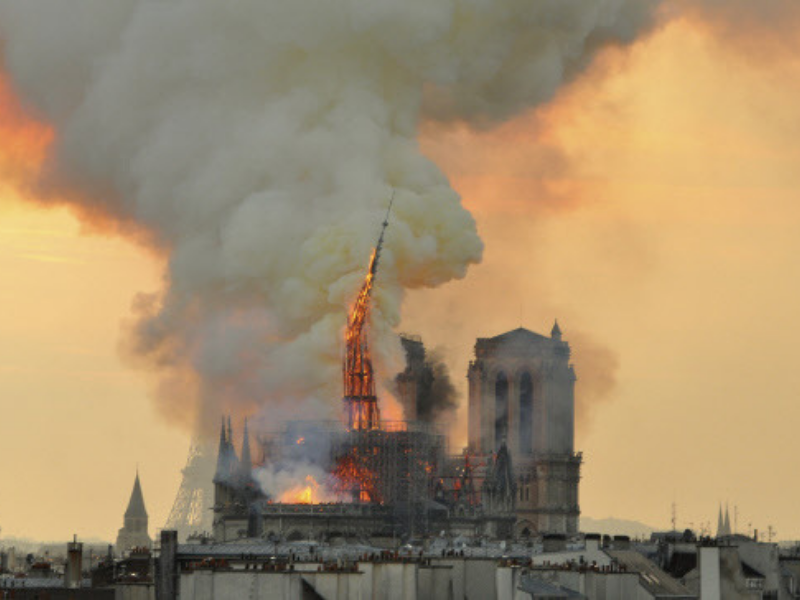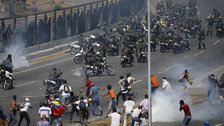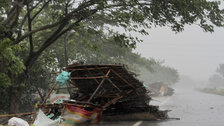PARIS: Fueled by a lattice of centuries-old timbers, the fire moved hungrily across Notre Dame’s rooftop toward the cathedral’s iconic spire. It belched yellow smoke, spitting out gritty particles of wood, stone, lead and iron and wanted more. Far below, their vision obscured by fumes and tears, firefighters, priests and municipal workers passed treasures hand-to-hand, hoping the speed of desperation could outrun the flames.
They had 66 minutes.
The first alarm sounded at 6:20 pm, silencing the priest and a few hundred worshippers and tourists inside.
“Everyone was immobilized by shock for maybe a minute,” said , who was in the organ loft as usual for the daily Mass on Monday. Shock, but no panic. The rear doors opened and within a few minutes, the cathedral was empty. Vexo, who had never before even heard the alarm go off, lingered for a bit then made his way home.
For 23 minutes, it seemed like a false alarm. Then at 6:43 pm a second smoke detector went off and the fire showed its face, flickering in the wooden timbers and visible to anyone looking north from Paris’ Left Bank.
The first firetrucks lumbered through rush-hour traffic, blasting their two-tone sirens at full volume to reach the island that is the historic and geographic heart of Paris. For that first half-hour, it looked like the fire couldn’t possibly leave more than a small age mark on the nearly 900-year-old building, more akin to the inevitable wear on stone’s rough edges than the fury of the French Revolution that left it in ruins for decades.
Across the Seine in City Hall, Mayor Anne Hidalgo glanced out the window during an evening meeting to see a yellow cloud blotting out the sky. She rushed to the island. So did Vexo, who had spotted the cloud from his home.
“I came here and felt powerless as the flames overtook the cathedral,” Hidalgo said. Vexo watched the flames for a minute or two from across the river then turned away. “It was unbearable,” he said.
Bridge after bridge along the Seine filled with somber onlookers, all facing the cathedral built for the ages. They dotted the stone walkways that line the river. They wept as flames melted the lead-lined roof and overtook the cathedral’s spire.
Below, nestled deep in the cathedral, was the treasure chest, keeper of Notre Dame’s most sacred relics.
Firefighters cracked the chest open, pulling out the Crown of Thorns revered as the one worn by Jesus Christ at his crucifixion. Made of rushes wrapped into a wreath and tied with gold filament, it had been kept under glass since 1896. The tunic of St. Louis, believed to have belonged to King Louis IX, came out of the chest along with fragments of the cross and a nail, said Patrick Chauvet, rector of Notre Dame Cathedral.
The relics were safe.
Then came the artwork.
“We had to get them, in the smoke, as debris was falling, to protect them,” Gen. Jean-Claude Gallet of the fire brigade told BFM television.
At 7:49 pm, the 19th-century spire that was the architectural masterpiece of Eugene Emmanuel Viollet-le-Duc and his post-Revolutionary restoration broke apart and fell through the nave. The bronze weathercock tumbled, taking with it three relics sealed inside in 1935.
It had been 66 minutes since the first flames were spotted.
The sky above the cathedral flamed orange, and the fire lurched toward Notre Dame’s iconic towers, then slipped inside.
Myriam Chudzinski was among 20 firefighters already there. Loaded with gear, they climbed hundreds of steps up the narrow spiral staircase to the top of one of the two towers. The chief corporal had trained at the cathedral for just this moment.
“We knew that the roof was burning, but we didn’t really know the intensity,” she said. “It was from upstairs that you understood that it was really dramatic. It was very hot and we had to retreat, retreat. It was spreading quickly.”
She heard a roar, but her focus was on saving the tower. She learned later that it was the sound of the spire collapsing.
The spire was lost. Could Notre Dame itself be saved? From inside and out, firefighters fought the battle of their lives, a battle for the ages.
At 9.49 pm, Laurent Nunez, deputy interior minister, voiced the fear that haunted Paris and beyond. The smell of smoke had long since reached beyond the city center, permeating homes and apartments miles (kilometers) away. Sirens wailed ceaselessly. Hundreds of firefighters were doing their utmost. And, Nunez said, no one knew whether it would be enough.
The 20 firefighters struggled on in the towers, while a remote-controlled robot moved into the nave.
Red-hot embers floated down from the glowing hole where the spire once stood, settling on the blackened marble floor and the pile of debris that was all that was left of the spire. It had been “a masterwork of Viollet-le-Duc” and a tribute to what restoration could achieve, said Kevin Murphy, an expert on historical restoration from . It was gone, as were the roof’s irreplaceable ancient wooden beams, cut from trees that were alive a millennium ago.
The robot was immune to the danger. The men and women battling inside and out were not.
At 11:23 pm, the fire chief said the rest of the structure, including the cathedral’s twin bell towers, had been saved. It had been within 30 minutes of collapse.
It took 10 more hours for the fire to be declared extinguished. The spire’s bronze rooster, long a symbol of France, was found Tuesday, deformed by the heat but recognizable nonetheless.
“Beyond emotion, beyond words, beyond tears,” Christophe Castaner, France’s interior minister, said Tuesday as he visited the cathedral, “What I want to express is the pride of the men and women who committed to saving Notre Dame.”



